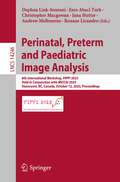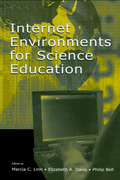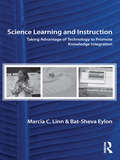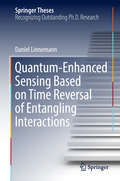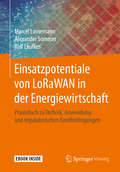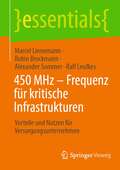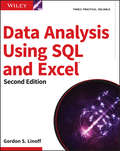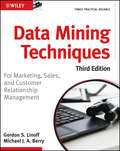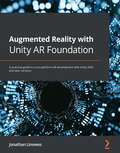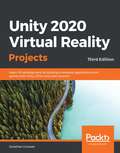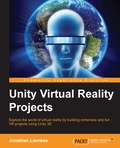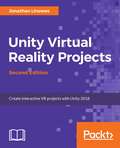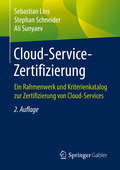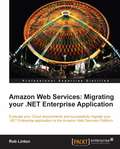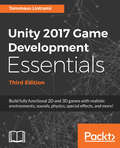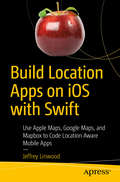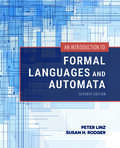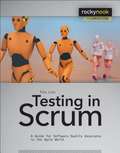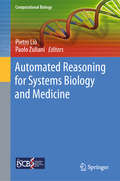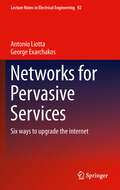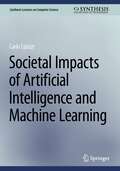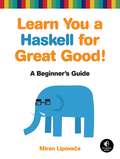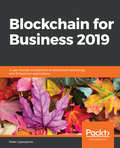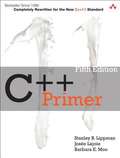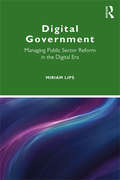- Table View
- List View
Perinatal, Preterm and Paediatric Image Analysis: 8th International Workshop, PIPPI 2023, Held in Conjunction with MICCAI 2023, Vancouver, BC, Canada, October 12, 2023, Proceedings (Lecture Notes in Computer Science #14246)
by Daphna Link-Sourani Esra Abaci Turk Christopher Macgowan Jana Hutter Andrew Melbourne Roxane LicandroThis book constitutes the refereed proceedings of the 8th International Workshop on Perinatal, Preterm and Paediatric Image Analysis, PIPPI 2023, held in conjunction with the 26th International Conference on Medical Imaging and Computer-Assisted Intervention, MICCAI 2023, in Vancouver, Canada, in October 2023.The 10 full papers presented at PIPPI 2023 were carefully reviewed and selected from 14 submissions. PIPPI 2023 workshop complements the main MICCAI conference by providing a focused discussion on the challenges of image analysis techniques as applied to the fetal and infant settings.
Internet Environments for Science Education
by Marcia C. LinnInternet Environments for Science Education synthesizes 25 years of research to identify effective, technology-enhanced ways to convert students into lifelong science learners--one inquiry project at a time. It offers design principles for development of innovations; features tested, customizable inquiry projects that students, teachers, and professional developers can enact and refine; and introduces new methods and assessments to investigate the impact of technology on inquiry learning. The methodology--design-based research studies--enables investigators to capture the impact of innovations in the complex, inertia-laden educational enterprise and to use these findings to improve the innovation. The approach--technology-enhanced inquiry--takes advantage of global, networked information resources, sociocognitive research, and advances in technology combined in responsive learning environments. Internet Environments for Science Education advocates leveraging inquiry and technology to reform the full spectrum of science education activities--including instruction, curriculum, policy, professional development, and assessment. The book offers: *the knowledge integration perspective on learning, featuring the interpretive, cultural, and deliberate natures of the learner; *the scaffolded knowledge integration framework on instruction summarized in meta-principles and pragmatic principles for design of inquiry instruction; *a series of learning environments, including the Computer as Learning Partner (CLP), the Knowledge Integration Environment (KIE), and the Web-based Inquiry Science Environment (WISE) that designers can use to create new inquiry projects, customize existing projects, or inspire thinking about other learning environments; *curriculum design patterns for inquiry projects describing activity sequences to promote critique, debate, design, and investigation in science; *a partnership model establishing activity structures for teachers, pedagogical researchers, discipline experts, and technologists to jointly design and refine inquiry instruction; *a professional development model involving mentoring by an expert teacher; *projects about contemporary controversy enabling students to explore the nature of science; *a customization process guiding teachers to adapt inquiry projects to their own students, geographical characteristics, curriculum framework, and personal goals; and *a Web site providing additional links, resources, and community tools at www.InternetScienceEducation.org
Science Learning and Instruction: Taking Advantage of Technology to Promote Knowledge Integration
by Marcia C. Linn Bat-Sheva EylonScience Learning and Instruction describes advances in understanding the nature of science learning and their implications for the design of science instruction. The authors show how design patterns, design principles, and professional development opportunities coalesce to create and sustain effective instruction in each primary scientific domain: earth science, life science, and physical science. Calling for more in depth and less fleeting coverage of science topics in order to accomplish knowledge integration, the book highlights the importance of designing the instructional materials, the examples that are introduced in each scientific domain, and the professional development that accompanies these materials. It argues that unless all these efforts are made simultaneously, educators cannot hope to improve science learning outcomes. The book also addresses how many policies, including curriculum, standards, guidelines, and standardized tests, work against the goal of integrative understanding, and discusses opportunities to rethink science education policies based on research findings from instruction that emphasizes such understanding.
Quantum‐Enhanced Sensing Based on Time Reversal of Entangling Interactions (Springer Theses)
by Daniel LinnemannQuantum mechanics entails effects like superpositions and entanglement, which have no classical counterparts. From a technological standpoint these counterintuitive quantum aspects can be viewed as an unexploited resource that can be harnessed to support various tasks, e.g. in the domains of computation, communication, and metrology. In many applications, however, the potential of nonclassical states cannot practically be exploited due to detection inefficiencies. The authors address this limitation by experimentally realizing a novel detection scheme in which entangling interactions are time reversed. In this way, nonclassical many-particle states are disentangled, allowing them to be detected in a robust and technically feasible manner. In the context of quantum metrology, these nonlinear readout techniques extend the class of entangled probe states that can be leveraged for sensing applications without being limited by finite detector resolution. The authors present an active atom interferometer, where both the entangled state preparation and disentangling readout involve parametric amplification. This “SU(1,1)” interferometer is implemented with the help of spinor Bose–Einstein condensates, where amplification is implemented by atomic collisions leading to spin exchange.
Einsatzpotentiale von LoRaWAN in der Energiewirtschaft: Praxisbuch zu Technik, Anwendung und regulatorischen Randbedingungen
by Marcel Linnemann Alexander Sommer Ralf LeufkesLoRAWAN stellte eine kostengünstige Technologie dar, mit der Prozesse innerhalb einer Stadt schnell und einfach vernetzt werden können. Für die Versorgungswirtschaft ergeben sich hieraus enorme potentiale und Geschäftsmodelle. Dieses Buch beschreibt die Technik, die Einsatzfelder, die Potentiale und die regulatorischen Anforderungen, die berücksichtigt werden müssen.
450 MHz – Frequenz für kritische Infrastrukturen: Vorteile und Nutzen für Versorgungsunternehmen (essentials)
by Marcel Linnemann Alexander Sommer Ralf Leufkes Robin BrockmannDie Sicherstellung einer zuverlässigen Versorgungsinfrastruktur zur Gewährleistung der Versorgungssicherheit stellt eines der zentralen Themen der Energieversorger in Deutschland dar. Einen wichtigen Beitrag soll hierfür die 450 MHz Frequenz als Frequenz für kritische Infrastrukturen leisten. Für Energieversorger stellt sich daher die Frage, in welchem Kontext die 450 Frequenz zu nutzen ist sowie welche Vor- und Nachteile 450 MHz mit sich bringt.Die Kurzfassung zum Thema 450 MHz – die Frequenz für kritische Infrastrukturen soll dem Leser einen ersten schnellen Einstieg in die energiewirtschaftliche Einordnung, die Frequenz und darauf basierende Technologie sowie die Einsatzmöglichkeiten im eigenen Energieversorgungsunternehmen bieten.
Data Analysis Using SQL and Excel
by Gordon S. LinoffUseful business analysis requires you to effectively transform data into actionable information. This book helps you use SQL and Excel to extract business information from relational databases and use that data to define business dimensions, store transactions about customers, produce results, and more. Each chapter explains when and why to perform a particular type of business analysis in order to obtain useful results, how to design and perform the analysis using SQL and Excel, and what the results should look like.
Data Mining Techniques
by Gordon S. Linoff Michael J. BerryThe leading introductory book on data mining, fully updated and revised!When Berry and Linoff wrote the first edition of Data Mining Techniques in the late 1990s, data mining was just starting to move out of the lab and into the office and has since grown to become an indispensable tool of modern business. This new edition--more than 50% new and revised-- is a significant update from the previous one, and shows you how to harness the newest data mining methods and techniques to solve common business problems. The duo of unparalleled authors share invaluable advice for improving response rates to direct marketing campaigns, identifying new customer segments, and estimating credit risk. In addition, they cover more advanced topics such as preparing data for analysis and creating the necessary infrastructure for data mining at your company. Features significant updates since the previous edition and updates you on best practices for using data mining methods and techniques for solving common business problemsCovers a new data mining technique in every chapter along with clear, concise explanations on how to apply each technique immediatelyTouches on core data mining techniques, including decision trees, neural networks, collaborative filtering, association rules, link analysis, survival analysis, and moreProvides best practices for performing data mining using simple tools such as ExcelData Mining Techniques, Third Edition covers a new data mining technique with each successive chapter and then demonstrates how you can apply that technique for improved marketing, sales, and customer support to get immediate results.
Augmented Reality with Unity AR Foundation: A practical guide to cross-platform AR development with Unity 2020 and later versions
by Jonathan LinowesExplore the world of augmented reality development with the latest features of Unity and step-by-step tutorial-style examples with easy-to-understand explanationsKey FeaturesBuild functional and interactive augmented reality applications using the Unity 3D game engineLearn to use Unity's XR and AR components, including AR Foundation and other standard Unity featuresImplement common AR application user experiences needed to build engaging applicationsBook DescriptionAugmented reality applications allow people to interact meaningfully with the real world through digitally enhanced content.The book starts by helping you set up for AR development, installing the Unity 3D game engine, required packages, and other tools to develop for Android (ARCore) and/or iOS (ARKit) mobile devices. Then we jump right into the building and running AR scenes, learning about AR Foundation components, other Unity features, C# coding, troubleshooting, and testing. We create a framework for building AR applications that manages user interaction modes, user interface panels, and AR onboarding graphics that you will save as a template for reuse in other projects in this book. Using this framework, you will build multiple projects, starting with a virtual photo gallery that lets you place your favorite framed photos on your real-world walls, and interactively edit these virtual objects. Other projects include an educational image tracking app for exploring the solar system, and a fun selfie app to put masks and accessories on your face. The book provides practical advice and best practices that will have you up and running quickly.By the end of this AR book, you will be able to build your own AR applications, engaging your users in new and innovative ways.What you will learnDiscover Unity engine features for building AR applications and gamesGet up to speed with Unity AR Foundation components and the Unity APIBuild a variety of AR projects using best practices and important AR user experiencesUnderstand the core concepts of augmented reality technology and development for real-world projectsSet up your system for AR development and learn to improve your development workflowCreate an AR user framework with interaction modes and UI, saved as a template for new projectsWho this book is forThis augmented reality book is for game developers interested in adding AR capabilities to their games and apps. The book assumes beginner-level knowledge of Unity development and C# programming, familiarity with 3D graphics, and experience in using existing AR applications. Beginner-level experience in developing mobile applications will be helpful to get the most out of this AR Unity book.
Unity 2020 Virtual Reality Projects: Learn VR development by building immersive applications and games with Unity 2019.4 and later versions, 3rd Edition
by Jonathan LinowesExplore the latest features of Unity and build VR experiences including first-person interactions, audio fireball games, 360-degree media, art gallery tours, and VR storytelling Key Features Discover step-by-step instructions and best practices to begin your VR development journey Explore Unity features such as URP rendering, XR Interaction Toolkit, and ProBuilder Build impressive VR-based apps and games that can be experienced using modern devices like Oculus Rift and Oculus Quest Book Description This third edition of the Unity Virtual Reality (VR) development guide is updated to cover the latest features of Unity 2019.4 or later versions - the leading platform for building VR games, applications, and immersive experiences for contemporary VR devices. Enhanced with more focus on growing components, such as Universal Render Pipeline (URP), extended reality (XR) plugins, the XR Interaction Toolkit package, and the latest VR devices, this edition will help you to get up to date with the current state of VR. With its practical and project-based approach, this book covers the specifics of virtual reality development in Unity. You'll learn how to build VR apps that can be experienced with modern devices from Oculus, VIVE, and others. This virtual reality book presents lighting and rendering strategies to help you build cutting-edge graphics, and explains URP and rendering concepts that will enable you to achieve realism for your apps. You'll build real-world VR experiences using world space user interface canvases, locomotion and teleportation, 360-degree media, and timeline animation, as well as learn about important VR development concepts, best practices, and performance optimization and user experience strategies. By the end of this Unity book, you'll be fully equipped to use Unity to develop rich, interactive virtual reality experiences. What you will learn Understand the current state of virtual reality and VR consumer products Get started with Unity by building a simple diorama scene using Unity Editor and imported assets Configure your Unity VR projects to run on VR platforms such as Oculus, SteamVR, and Windows immersive MR Design and build a VR storytelling animation with a soundtrack and timelines Implement an audio fireball game using game physics and particle systems Use various software patterns to design Unity events and interactable components Discover best practices for lighting, rendering, and post-processing Who this book is for Whether you're a non-programmer unfamiliar with 3D computer graphics or experienced in both but new to virtual reality, if you're interested in building your own VR games or applications, this Unity book is for you. Any experience in Unity will be useful but is not necessary.
Unity Virtual Reality Projects
by Jonathan LinowesExplore the world of Virtual Reality by building immersive and fun VR projects using Unity 3D About This Book * Learn the basic principles of virtual reality applications and get to know how they differ from games and desktop apps * Build various types of VR experiences, including diorama, first-person characters, riding on rails, 360 degree projections, and social VR * A project-based guide that teaches you to use Unity to develop VR applications, which can be experienced with devices such as the Oculus Rift or Google Cardboard Who This Book Is For If you're a non-programmer unfamiliar with 3D computer graphics, or experienced in both but new to virtual reality, and are interested in building your own VR games or applications then this book is for you. Any experience in Unity is an advantage. What You Will Learn * Create 3D scenes with Unity and Blender while learning about world space and scale * Build and run VR applications for consumer headsets including Oculus Rift and Google Cardboard * Build interactive environments with physics, gravity, animations, and lighting using the Unity engine * Experiment with various user interface (UI) techniques that you can use in your VR applications * Implement the first-person and third-person experiences that use only head motion gestures for input * Create animated walkthroughs, use 360-degree media, and build multi-user social VR experiences * Learn about the technology and psychology of VR including rendering, performance and VR motion sickness * Gain introductory and advanced experience in Unity programming with the C# language In Detail What is consumer "virtual reality"? Wearing a head-mounted display you view stereoscopic 3D scenes. You can look around by moving your head, and walk around using hand controls or motion sensors. You are engaged in a fully immersive experience. On the other hand, Unity is a powerful game development engine that provides a rich set of features such as visual lighting, materials, physics, audio, special effects, and animation for creating 2D and 3D games. Unity 5 has become the leading platform for building virtual reality games, applications and experiences for this new generation of consumer VR devices. Using a practical and project-based approach, this book will educate you about the specifics of virtual reality development in Unity. You will learn how to use Unity to develop VR applications which can be experienced with devices such as the Oculus Rift or Google Cardboard. We will then learn how to engage with virtual worlds from a third person and first person character point of view. Furthermore, you will explore the technical considerations especially important and possibly unique to VR. The projects in the book will demonstrate how to build a variety of VR experiences. You will be diving into the Unity 3D game engine via the interactive Unity Editor as well as C-Sharp programming. By the end of the book, you will be equipped to develop rich, interactive virtual reality experiences using Unity. So, let's get to it! Style and approach This book takes a practical, project-based approach to teach specifics of virtual reality development in Unity. Using a reader-friendly approach, this book will not only provide detailed step-by-step instructions but also discuss the broader context and applications covered within.
Unity Virtual Reality Projects: Learn Virtual Reality by developing more than 10 engaging projects with Unity 2018, 2nd Edition
by Jonathan LinowesExplore the latest features of Unity 2018 to create immersive VR projects for Oculus Rift, HTC Vive, Daydream and Gear VRKey FeaturesA project-based guide to teach you how to develop immersive and fun VR applications using Unity 3DBuild experiences with interactable objects, physics, UI, animations, C# scripting, and other Unity featuresExplore the world of VR by building experiences such as diorama, first-person characters, 360-degree projections, social VR, audio fireball game, and VR storytelling Book DescriptionUnity has become the leading platform for building virtual reality games, applications, and experiences for this new generation of consumer VR devices. Unity Virtual Reality Projects walks you through a series of hands-on tutorials and in-depth discussions on using the Unity game engine to develop VR applications. With its practical and project-based approach, this book will get you up to speed with the specifics of VR development in Unity. You will learn how to use Unity to develop VR applications that can be experienced with devices such as Oculus, Daydream, and Vive. Among the many topics and projects, you will explore gaze-based versus hand-controller input, world space UI canvases, locomotion and teleportation, software design patterns, 360-degree media, timeline animation, and multiplayer networking. You will learn about the Unity 3D game engine via the interactive Unity Editor, and you will also learn about C# programming. By the end of the book, you will be fully equipped to develop rich, interactive VR experiences using Unity.What you will learnCreate 3D scenes with Unity and other 3D tools while learning about world space and scaleBuild and run VR applications for specific headsets, including Oculus, Vive, and DaydreamInteract with virtual objects using eye gaze, hand controllers, and user input eventsMove around your VR scenes using locomotion and teleportationImplement an audio fireball game using physics and particle systemsImplement an art gallery tour with teleportation and data infoDesign and build a VR storytelling animation with a soundtrack and timelinesCreate social VR experiences with Unity networkingWho this book is forIf you're a non-programmer unfamiliar with 3D computer graphics, or experienced in both but new to virtual reality, and are interested in building your own VR games or applications, then this book is for you. Any experience in Unity is an advantage.
Cloud-Service-Zertifizierung: Ein Rahmenwerk und Kriterienkatalog zur Zertifizierung von Cloud-Services
by Sebastian Lins Stephan Schneider Ali SunyaevDieses Buch liefert ein Rahmenwerk zur Zertifizierung von Services in der Cloud. Herzstück dabei ist ein umfangreicher Kriterienkatalog zum Assessment von Cloud-Services, der im Forschungsprojekt „Value4Cloud“ , gefördert vom Bundesministerium für Wirtschaft und Technologie, entwickelt wurde. Cloud-Service-Anwender werden bei der Bewertung, dem Vergleich und der Auswahl von Services unterstützt. Das Buch eignet sich auch für Cloud-Service-Anbieter zum Self-Assessment und zur Verbesserung der eigenen Services.
Amazon Web Services: Migrating your .NET Enterprise Application
by Rob LintonThis practical, step-by-step guide follows the process of moving a sample Enterprise .NET application to the Amazon Cloud.Companies that have designed, developed, and hosted applications based on the Microsoft .NET technology stack should not miss out on this book. If you are looking to expand into using the vast array of services available on the Amazon Cloud but are unsure how to proceed, then this will help to get you on your way.Administrators or developers managing such applications should have basic experience of the platform and the web servers that thay are intending to move to Amazon. No knowledge of AWS is required.
Unity 2017 Game Development Essentials, Third Edition: Build fully functional 2D and 3D games with realistic environments, sounds, physics, special effects, and more!
by Tommaso Lintrami Will GoldstoneGo through 3D game development techniques using Unity Key Features Kick-start your game development carrer and build ready-to-play 2D and 3D games with ease Understand the key concepts in game design including scripting, physics, instantiation, particle effects, and more Build games that run on desktop, mobile, and the web Book Description Unity is the most popular game engine among Indie developers, start-ups, and medium to large independent game development companies. This book is a complete exercise in game development covering environments, physics, sound, particles, and much more—to get you up and running with Unity rapidly. In this informal guide, you’ll get to grips with the basics of game development, starting off with using C# for scripting. You'll get the hang of Unity's development environment and will be able to set up the required assets for your frst 2D game. You'll work on animating your player and getting it to move in the 2D environment. Next, you'll see how to build the game in 3D, making use of Unity's new 3D animation system. After building a beautiful 3D environment for the game, you’ll work with the latest physics system that Unity has to offer and will make your assets interactive. You'll induce artifcial intelligence into the enemies and develop a mechanism to hit them with rocks and punches. Once you've made things pretty with the particle system, you'll move on to optimize the game, adding a cross-platform ready UI, and publishing your game across multiple platforms. You'll walk away with a cool 2D parallax side parallax game and an even cooler third-person 3D adventure game, but most importantly, with the confdence to build your own games. What you will learn Script games using C# Build your very first 2D and 3D games Work through the key concepts in game development such as animations, physics, and scripting Test and optimize your games to attain great performance Create fully functional menus, HUDs, and UI Create player character interactions with AI and NPC Who this book is for Who this book is written for: If you're a designer or animator who wishes to take their first steps into game development or prototyping, or if you've simply spent many hours sitting in front of video games with ideas bubbling away in the back of your mind, Unity and this book should be your starting point.
Build Location Apps on iOS with Swift: Use Apple Maps, Google Maps, and Mapbox to Code Location Aware Mobile Apps
by Jeffrey LinwoodWork with Apple Maps, Google Maps, and Mapbox in iOS with Swift programming. Guided by practical examples, this book covers all three map frameworks to ensure you properly select which one best suits your iOS app's needs in working with iOS location.You'll see how Apple's privacy settings apply to a user's location, and how to access that user's location from an application. Once you have access to the user's location, allow your app to display points of interest from Apple's database on the map inside the app, as well as to provide a search through that database by name. You can also incorporate turn by turn directions inside your own app to provide routes. Or trigger different functionality or notifications based on locational queues. With Build Location Apps on iOS with Swift, you'll even find out how to provide offline map support for hiking, camping, or other outdoors applications where cell phone service is weak.What You'll LearnDisplay points of interest within your own appWork with Apple's privacy settings so pertinent information comes throughTrigger functionality based on geographic promptsCreate your own custom map styles with Mapbox Studio and display them in the appWho This Book Is ForIntermediate to advanced Swift programmers who would like to add location based services to their apps.
An Introduction to Formal Languages and Automata
by Peter Linz Susan H. RodgerAn Introduction to Formal Languages and Automata, Seventh Edition is designed for an introductory course on formal languages, automata, compatibility, and related matters forming what is known as the theory of computation.
Testing in Scrum
by Tilo LinzThese days, more and more software development projects are being carried out using agile methods like Scrum. Agile software development promises higher software quality, a shorter time to market, and improved focus on customer needs. However, the transition to working within an agile methodology is not easy. Familiar processes and procedures change drastically. Software testing and software quality assurance have a crucial role in ensuring that a software development team, department, or company successfully implements long-term agile development methods and benefits from this framework. This book discusses agile methodology from the perspective of software testing and software quality assurance management. Software development managers, project managers, and quality assurance managers will obtain tips and tricks on how to organize testing and assure quality so that agile projects maintain their impact. Professional certified testers and software quality assurance experts will learn how to work successfully within agile software teams and how best to integrate their expertise. Topics include:Agile methodology and classic process models How to plan an agile project Unit tests and test first approach Integration testing and continuous integration System testing and test nonstop Quality management and quality assurance Also included are five case studies from the manufacturing, online-trade, and software industry as well as test exercises for self-assessment. This book covers the new ISTQB Syllabus for Agile Software Testing and is a relevant resource for all students and trainees worldwide who plan to undertake this ISTQB certification.
Automated Reasoning for Systems Biology and Medicine (Computational Biology #30)
by Pietro Liò Paolo ZulianiThis book presents outstanding contributions in an exciting, new and multidisciplinary research area: the application of formal, automated reasoning techniques to analyse complex models in systems biology and systems medicine. Automated reasoning is a field of computer science devoted to the development of algorithms that yield trustworthy answers, providing a basis of sound logical reasoning. For example, in the semiconductor industry formal verification is instrumental to ensuring that chip designs are free of defects (or “bugs”). Over the past 15 years, systems biology and systems medicine have been introduced in an attempt to understand the enormous complexity of life from a computational point of view. This has generated a wealth of new knowledge in the form of computational models, whose staggering complexity makes manual analysis methods infeasible. Sound, trusted, and automated means of analysing the models are thus required in order to be able to trust their conclusions. Above all, this is crucial to engineering safe biomedical devices and to reducing our reliance on wet-lab experiments and clinical trials, which will in turn produce lower economic and societal costs. Some examples of the questions addressed here include: Can we automatically adjust medications for patients with multiple chronic conditions? Can we verify that an artificial pancreas system delivers insulin in a way that ensures Type 1 diabetic patients never suffer from hyperglycaemia or hypoglycaemia? And lastly, can we predict what kind of mutations a cancer cell is likely to undergo? This book brings together leading researchers from a number of highly interdisciplinary areas, including: · Parameter inference from time series · Model selection · Network structure identification · Machine learning · Systems medicine · Hypothesis generation from experimental data · Systems biology, systems medicine, and digital pathology · Verification of biomedical devices “This book presents a comprehensive spectrum of model-focused analysis techniques for biological systems ...an essential resource for tracking the developments of a fast moving field that promises to revolutionize biology and medicine by the automated analysis of models and data.”Prof Luca Cardelli FRS, University of Oxford
Networks for Pervasive Services
by Antonio Liotta George ExarchakosReaders will progress from an understanding of what the Internet is now towards an understanding of the motivations and techniques that will drive its future.
Societal Impacts of Artificial Intelligence and Machine Learning (Synthesis Lectures on Computer Science)
by Carlo LipizziThis book goes beyond the current hype of expectations generated by the news on artificial intelligence and machine learning by analyzing realistic expectations for society, its limitations, and possible future scenarios for the use of this technology in our current society. Artificial Intelligence is one of the top topics today and is inflating expectations beyond what the technology can do in the foreseeable future. The future cannot be predicted, but the future of some elements of our society, such as technology, can be estimated. This book merges the modeling of human reasoning with the power of AI technology allowing readers to make more informed decisions about their personal or financial decisions or just being more educated on current technologies. This book presents a model that sketches potential future scenarios based on a discussion of the expectations today, the analysis of the current gap in the literature, and a view of possible futures in terms of technology and use cases. Specifically, this book merges literature on the technology aspects, the sociological impacts, and philosophical aspects.
Learn You a Haskell for Great Good!: A Beginner's Guide (No Starch Press Ser.)
by Miran Lipovaca<P>It's all in the name: Learn You a Haskell for Great Good! is a hilarious, illustrated guide to this complex functional language. Packed with the author's original artwork, pop culture references, and most importantly, useful example code, this book teaches functional fundamentals in a way you never thought possible. <P>You'll start with the kid stuff: basic syntax, recursion, types and type classes. Then once you've got the basics down, the real black belt master-class begins: you'll learn to use applicative functors, monads, zippers, and all the other mythical Haskell constructs you've only read about in storybooks. <P>As you work your way through the author's imaginative (and occasionally insane) examples, you'll learn to: <br>–Laugh in the face of side effects as you wield purely functional programming techniques <br>–Use the magic of Haskell's "laziness" to play with infinite sets of data <br>–Organize your programs by creating your own types, type classes, and modules <br>–Use Haskell's elegant input/output system to share the genius of your programs with the outside world <P>Short of eating the author's brain, you will not find a better way to learn this powerful language than reading Learn You a Haskell for Great Good!
Blockchain for Business 2019: A user-friendly introduction to blockchain technology and its business applications
by Peter LipovyanovYour one-stop guide to blockchain technology and its business applications Key Features Assimilate blockchain services such as Ethereum and Hyperledger to transform industrial applications Know in and out of blockchain technology to understand various business use cases Understand various common and not-so-common challenges faced in blockchain development Book Description Blockchain for Business 2019 is a comprehensive guide that enables you to bring in various blockchain functionalities to extend your existing business models and make correct fully-informed decisions. You will learn how decentralized applications are transforming numerous business sectors that are expected to play a huge role in the future. You will see how large corporations are already implementing blockchain technology now. You will then learn about the various blockchain services, such as Bitcoin, Ethereum, Hyperledger, and others to understand their use cases in a variety of business domains. You will develop a solid fundamental understanding of blockchain architecture. Moving ahead, you will get to grips with the inner workings of blockchain, with detailed explanations of mining, decentralized consensus, cryptography, smart contracts, and many other important concepts. You will delve into a realistic view of the current state of blockchain technology, along with its issues, limitations, and potential solutions that can take it to the next level. By the end of this book, you will all be well versed in the latest innovations and developments in the emerging blockchain space. What you will learn Understand the fundamentals of blockchain and how it was developed Gain a good understanding of economic concepts and developments Develop a base for concepts such as cryptography, computer networking, and programming Understand the applications of blockchain and its potential impact on the world Become well versed with the latest developments in the blockchain space Explore blockchain frameworks, including decentralized organizational structures, networks, and applications Who this book is for This book is for financial professionals, business executives, managers, and enthusiasts who are interested in getting well-versed with blockchain technology in various business domains. This book will help boost your existing business models using blockchain services. No prior experience of blockchain is required.
C++ Primer
by Stanley B. Lippman Josée Lajoie Barbara E. MooFully updated and recast for the newly released C++11 standard, this authoritative and comprehensive introduction to C++ will help you to learn the language fast, and to use it in modern, highly effective ways. Highlighting today’s best practices, the authors show how to use both the core language and its standard library to write efficient, readable, and powerful code. C++ Primer, Fifth Edition, introduces the C++ standard library from the outset, drawing on its common functions and facilities to help you write useful programs without first having to master every language detail. The book’s many examples have been revised to use the new language features and demonstrate how to make the best use of them. This book is a proven tutorial for those new to C++, an authoritative discussion of core C++ concepts and techniques, and a valuable resource for experienced programmers, especially those eager to see C++11 enhancements illuminated. Start Fast and Achieve More Learn how to use the new C++11 language features and the standard library to build robust programs quickly, and get comfortable with high-level programming Learn through examples that illuminate today’s best coding styles and program design techniques Understand the “rationale behind the rules”: why C++11 works as it does Use the extensive crossreferences to help you connect related concepts and insights Benefit from up-to-date learning aids and exercises that emphasize key points, help you to avoid pitfalls, promote good practices, and reinforce what you’ve learned
Digital Government: Managing Public Sector Reform in the Digital Era (Routledge Masters in Public Management)
by Miriam LipsDigital Government: Managing Public Sector Reform in the Digital Era presents a public management perspective on digital government and technology-enabled change in the public sector. It incorporates theoretical and empirical insights to provide students with a broader and deeper understanding of the complex and multidisciplinary nature of digital government initiatives, impacts and implications. The rise of digital government and its increasingly integral role in many government processes and activities, including overseeing fundamental changes at various levels across government, means that it is no longer perceived as just a technology issue. In this book Miriam Lips provides students with practical approaches and perspectives to better understand digital government. The text also explores emerging issues and barriers as well as strategies to more effectively manage digital government and technology-enabled change in the public sector. Digital Government is the ideal book for postgraduate students on courses in public administration, public management, public policy, political science and international relations, and e-government. It is also suitable for public service managers who are experiencing the impact of digital technology and data in the public sector.
